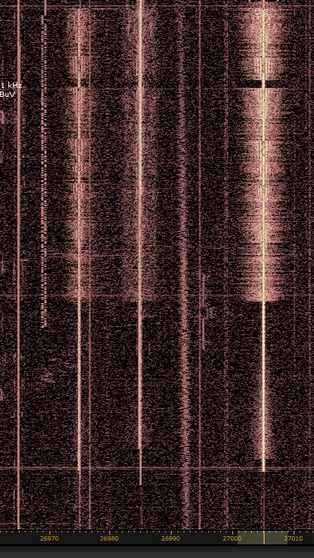
On 08-Oct-2022 I observed parallel signals on 26975, 26985 and 27005 KHz for the 1st time. The latter seemed to include activation signals. Language was Italian. What kind of network could that be?


Patterns like this one regularly appear, especially when a directional antenna is pointing into the opposite direction. This can only be the result of airplane reflections. The image shows about 30 seconds receiving DR P1 from Aarhus (159 km to the north) while beaming south with a 12 element. The turning point in the middle most probably indicates the moment when the indirect path (from receiver over the airplane to the transmitter) reaches its minimum.
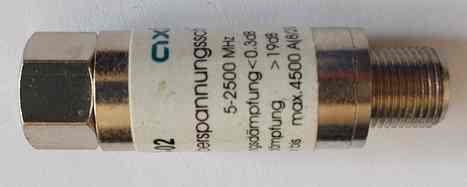
This is a part with F-connectors typically used for blocking LNB voltage from a satellite receiver or for high voltage / lightning protection. I was hoping that it would attenuate frequencies below 5 MHz as indicated. But it does not even attenuate at 15 KHz. The idea was to build a combiner for an HF/MF antenna (ALA1530LNP) and a VHF-FM antenna using a high pass filter feeding my Airspy HF+ Discovery SDR receiver. Unfortunately, the FM antenna catches a lot of local interference below 5 MHz. This part will not help.
11-Aug-2020
The TII codes for transmitter location identification as shown in the QIRX software show all received locations - no matter which MUX/ensemble/bouquet is synched or decoded. In my case, on 10C I often receive and decode NDR SH HEI from Helgoland with TII 1501 (eID 1179) while at the same time TII 1304 from NDR SH NOR (eID 1189) is shown from the Hamburg transmitter. The stronger station usually has a strength of 0.95 while the inferior one remains stable at 0.3-0.5 levels.
On 24-Aug-2019 / 1400 UTC a sporadic E cloud appeared only about 150 km south of my location. Sporadic E broadcast signal logs (65-108 MHz) by other DXers (fmlist) indicating the area of strongest reflection near Hamburg.
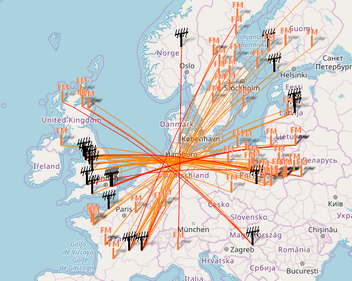
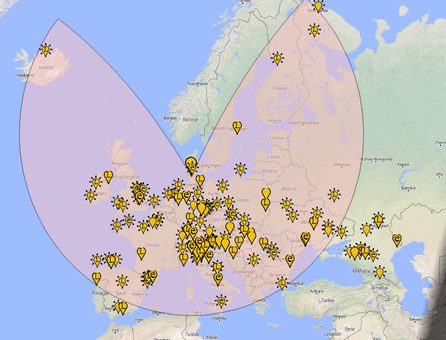 20m
20m
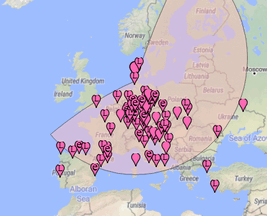 10m
10m
 6m
6m
On days without sporadic E the usual 20m skip zone is 700 km at noon. This map is from 08-Oct-2022 10.30 UTC.
original:
corrupted spectrum:
By the way: It would be a good idea if SDR WFM/NFM demodulators cut the audio spectrum above half of the IF bandwidth (20 KHz BW can only deliver audio/MPX up to 10 KHz). Theoretically no signals can exceed the range.

35 / 36 MHz repeater signals
During Sporadic E openings it is worth checking the whole spectrum above 30 MHz. 30-87.5 MHz is rather empty nowadays except amateur radio on 50 MHz, some remaining TV signals and OIRT FM (66-74 MHz) from East Europe. But one thing appears regularly: These signals between 35 and 37 MHz, NFM with a beep and nothing else. Pagers? 12.5 KHz spacing on multiples of this.
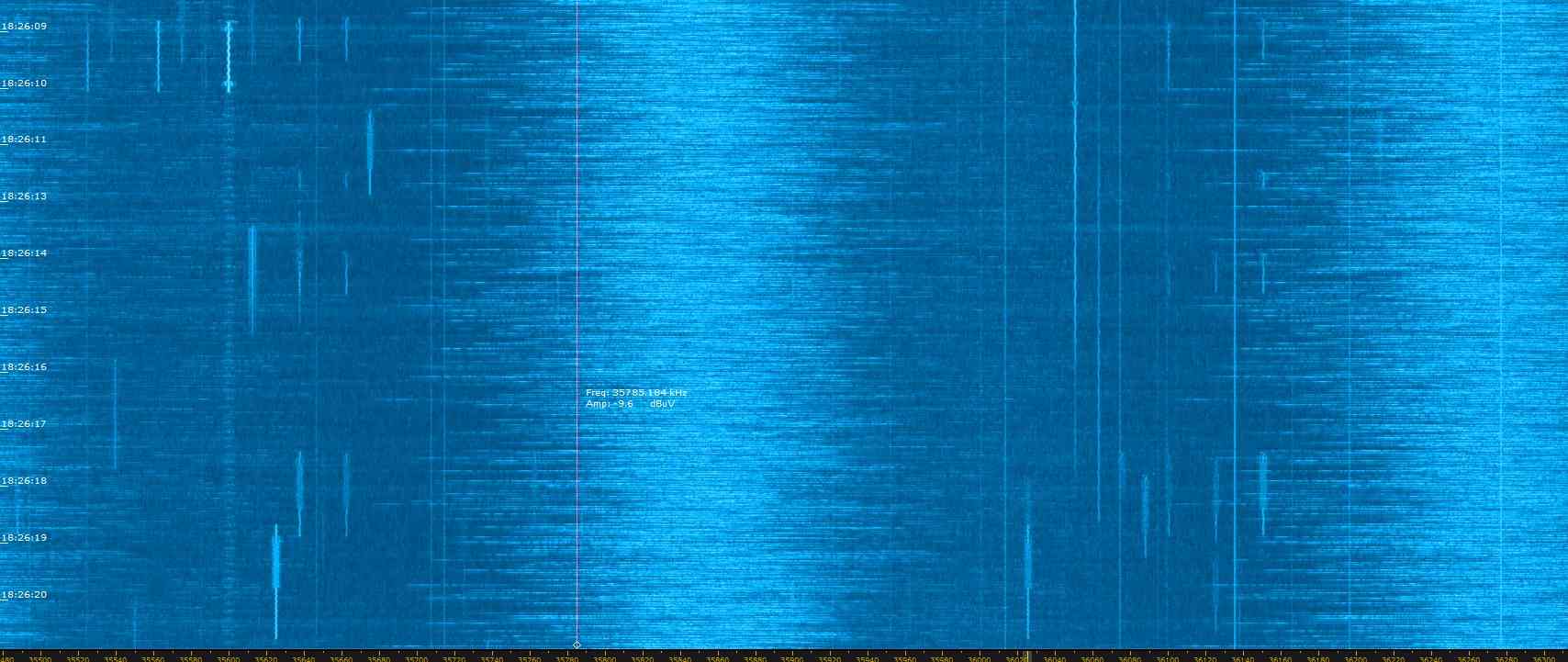
SDRSharp MPX output: check for latest version
I'm using Virtual Audio Cable VAC or VB Hifi Cable to feed RDS Spy with the Perseus recordings. The best combination as a result of intensive testing. You must have the MPX output installed and set sample rates of playback and recording in the sound settings to identical SR 192000Hz (and identical channel/bits). RDS Spy setting: direct from soundcard 192 KHz.
Important to know: The 2015 SDRSharp.OutMPX.dll only works with older versions (tested on 1525). If you use it with newer versions (as 1666)
it delivers a corrupt spectrum: 0-7.5 KHz instead of 15 KHz and a block above around 26 KHz, no MPX 19 (resp 9.5) KHz carrier, no RDS data traces. For the newer versions you need an updated MPX-dll. The one from 2017 works with SDR# v1.0.0.1666.


Power switches emit more QRN when they are close to their limit
Noise on MW/LW grows rapidly when e.g. a 2A switch produced that much. In this case try a 5A switch or even larger.
Thunderstorm bursts similar to meteor scatter, but shorter distances
This morning: a thunderstorm only a few km to the south, logper ant to that direction. Tuned to 97 MHz, almost no tropo, Bob Kiel (100w, 70 km) is stronger than WDR Bielstein (100KW, 320 km). But during every flash a short burst of a few 100 ms of Bielstein at about 10 dBµV appears.
Signal level of Opel test mode close to dBµV
The Opel car radio CD MP30 (not only this one) offers a test mode which you can enter by long-pressing "SETTINGS", wait for the beep, press SETTINGS again and then FM. The display will switch to something like "89.6 66 A001" (frequency / signal strength / RDS and SNR evaluation). I've compared signal strength value to dBµV measurements of a dipole antenna in a simular position with a quick check. Up to 40 dB the values are almost equal. Signal 50 is about 55 dB, signal 60 is 65 dB, signal 63 is 70 dB, signal 66 (maximum) is 75 dB and all above. Maybe it's the preamp that flattens the higher values.
Experiencing the "Luxemburg" effect
11-Mar-2017
Since the end of France Inter on the Allouis 162 KHz transmitter, the effect has been discussed again. On LW some stations seem to carry the modulation of other LW frequencies. On the empty carrier 162, now a mixture of Europe 1 (183 KHz) and RMC (234) can be heard here. Mathematically there is no connection. And here in Handewitt, 234 is not a strong signal (34 dBµV). This would speak for the assumption that the modulation is originated on the transmitter size, where 183 and 234 definitely come in strong. On the other hand observing 279 KHz with weak modulated TR1 Watan radio from Turkmenistan, you can hear the Polskie Radio Jedynka from 225 KHz in the background (quite a distance from Turkmenistan). Switching to a remote Perseus receiver in Doha (UAE), Watan Radio can be heard without Poland. So the original signal is clean. This all makes the thesis about a modulated ionosphere plausible. Turkmenistan and Poland are east from here (97 and 105 °). The Turkmenistan path leads over Poland. 162/183/234 are all from the Southwest (213/198/201 °). A little confusing that RMC 234 is behind Allouis - this cannot be the path. Is the signal in Nothern France still strong enough to cause the effect? Seems to...
Airspy Mini with TV Sharp
TV# is an extension that enables SDR# to display TV pictures. DX advise: use bandwidth decimation. With 380 KHz BW you can already decode something visible even if the signal is relatively weak (carrier 30-40 dB above floor). Use decimation for this purpose (3 MSPS / 8). This is some East European TV signal on R1 / offset 8M via Sporadic E propagation received in Handewitt, Germany (18.6.2016).
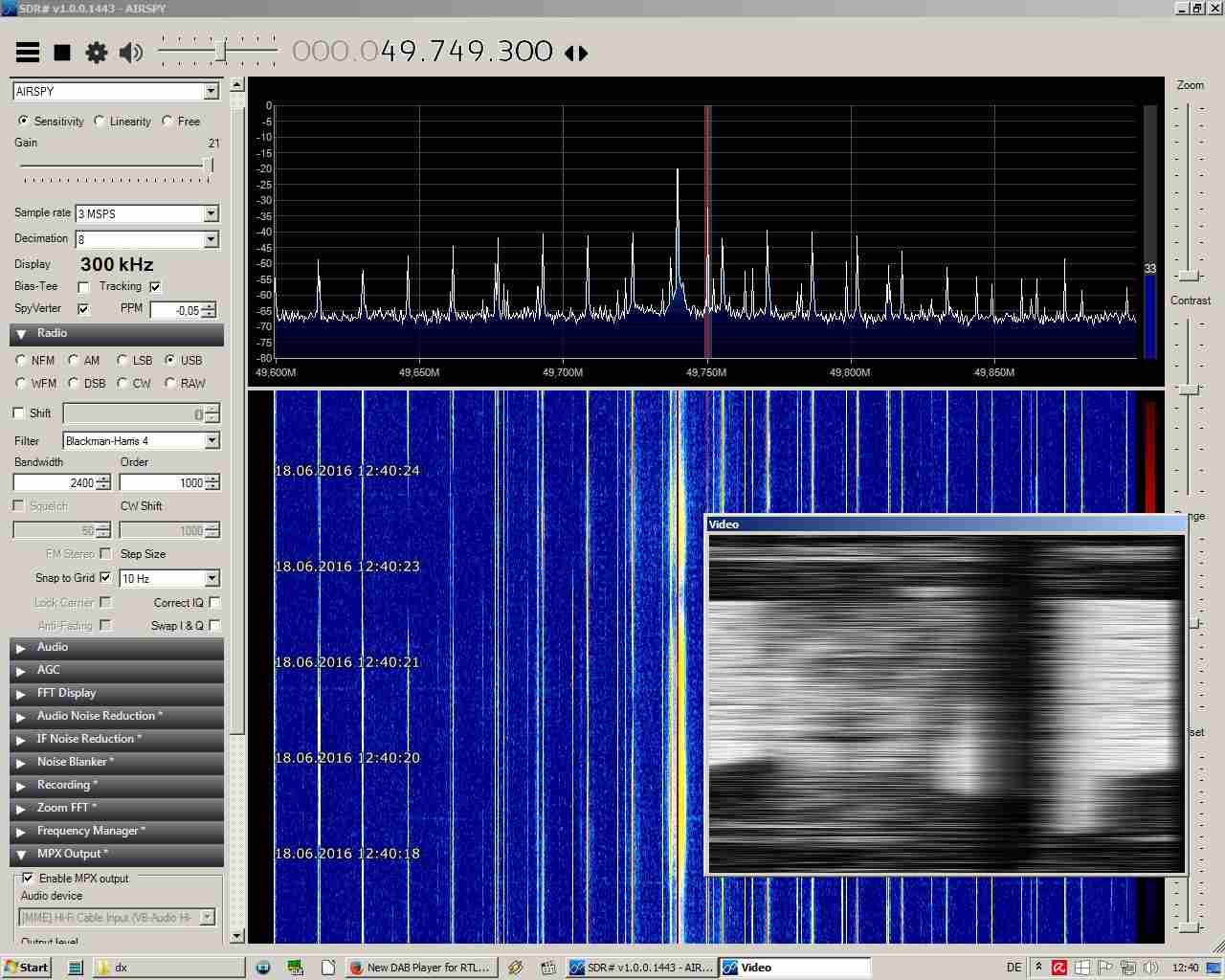
UK and Ireland medium wave pirates
Yes, there is some activity, not only the well known 549 Spirit R / 846 R North / 981 Star Country. Apart from that I could receive some loop music station on 612.007 and tweo guys with Scottish accent talking on 1530.06 via the Scottish Perseus receiver. Definitely not Celtic Music R from Glasgow.
9.2.2014
avoid LED bulbs and tubes
a few of the the ones I've tried produce heavy noise on MW/SW which make DX almost impossible. Be aware!
AM modulation levels
It's amazing how different they are. Audio peaks of well modulated stations usually reach up to about -8 dB relative to the carrier. In combination with a satisfying spectral compression this leads to a satisfying efficiency and a good SNR. Maybe half of the power goes into the modulation. This is a reason why many low power stations from the UK make a fat signal all over Europe. An example for the other extreme is Belarus Radio on 279 KHz. They seem to make only -18 dB without compression. For the 500 KW tranbsmitter this means: Only about 10 KW carry the information. Maybe it would be worth considering to list the modulation power in DX lists.
By the way this stuck me when I was searching for a parallel frequency for current OIRT-FM receptions. The web stream of BR1 is off, the SW schedule seems to be cut down to a few hours.
16.05.2013
Midnight sun around the the polar circle opens bands for Sporadic E and SW reception
Recently I wondered a little that the 68 MHz opening to the Arkhangelsk area remained stable till 2100 UTC (midnight there). It's not getting dark there. This could be a factor. I was also amazed that I could receive many stations on the higher 19 and 16m SW bands using the Karelia Perseus DX receiver around midnight. This was not short skip, it was world wide reception to Siberia, the Carrebean and the USA.
16.05.2013
Scandinavian CB in Moscow
While there was constant Sporadic E activity with some OIRT FM stations coming in here from Russia, it was nice to check the back link via the Moscow Perseus receiver. Found some CB activity from Denmark and Sweden.
05.2013
North Korea strong in Japan
On the Japan Perseus remote receivers you can see how active the North Koreans are. Of course you can get some of their SW services here. But there, they're all over the SW band. I tuned over 25m on a Japanese morning. And Chinas domestic services all over the place of course.
08.01.2011 01:30
Wide AM in Japan
It also occurred to me again that 2 x 10 KHz wide AM modulation is the common standard in Japan. Sounds much better than our strict 4,5 KHz limits here in Germany.
08.01.2011 01:30
Pirates beyond their "48m band"
Some years ago they were concentrated between 6200-6300 khz. But not anymore it seems. Some were on 6385, 6450. And 6930 /6940 have become common frequencies, too.
08.01.2011 10:28
Australia without interference
Things have changed since the 80ies. Back then it was rather difficult to get Radio Australia or New Zealand because the SW bands were full. Now it has become so easy. Just listening on 11945. Clear frequency. Nice audio.
08.01.2012 10:43
new AM bandwidth record
While China regularly modulates with 2 x 10KHz audio I just came across Radio Rossii on 12075 KHz doing 2 x 14 KHz. Needs to be notched at 5 KHz. But a good experience. But even there is SAM mode, fading still disturbs the audio. This is the main field where DRM could gain score. On the other hand, AM signals never completely disappear in difficult situations while DRM would abruptly stop. In the spectrum you can clearly see the fading lines and the fact that audio is cut above 4,5 KHz by some extent.
back to Radiovibrations.com